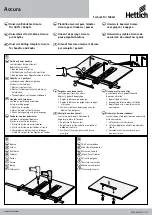
20 ENGLISH
Chipping/Scaling/Demolition
Set the action mode changing knob to the symbol.
Hold the tool firmly with both hands. Turn the tool on.
Apply feed force to the switch handle (main handle) for
working accuracy and efficiency, and hold the side grip
(auxiliary handle) to keep balance of the tool.
Pressing very hard on the tool will not increase the
efficiency.
►
Fig.36
Drilling in wood or metal
CAUTION:
Hold the tool firmly and exert care
when the drill bit begins to break through the
workpiece.
There is a tremendous force exerted on
the tool/drill bit at the time of hole break through.
CAUTION:
A stuck drill bit can be removed
simply by setting the reversing switch to reverse
rotation in order to back out. However, the tool
may back out abruptly if you do not hold it firmly.
CAUTION:
Always secure workpieces in a
vise or similar hold-down device.
NOTICE:
Never use “rotation with hammering”
when the drill chuck is installed on the tool.
The
drill chuck may be damaged.
Also, the drill chuck will come off when reversing the
tool.
NOTICE:
Pressing excessively on the tool will
not speed up the drilling.
In fact, this excessive
pressure will only serve to damage the tip of your drill
bit, decrease the tool performance and shorten the
service life of the tool.
Set the action mode changing knob to the symbol.
Installing drill chuck set
Optional accessory
Attach the chuck adapter to a keyless drill chuck to
which 1/2"-20 size screw can be installed, and then
install them to the tool. For details on how to install
the adapter into the chuck, refer to the instructions on
installing drill bit.
►
Fig.37:
1.
Keyless drill chuck
2.
Chuck adapter
Diamond core drilling
NOTICE:
If performing diamond core drilling
operations using “rotation with hammering”
action, the diamond core bit may be damaged.
When performing diamond core drilling opera-
tions, always set the action mode changing knob to
the position to use "rotation only" action.
Beating dust on the filter
Optional accessory
CAUTION:
Do not turn the dial on the dust case
while the dust case is removed from the dust collec-
tion system.
Doing so may cause dust inhalation.
CAUTION:
Always switch off the tool when
turning the dial on the dust case.
Turning the dial
while the tool is running may result in the loss of
control of the tool.
By beating the dust on the filter inside the dust case,
you can keep the vacuum efficiency and also reduce
the number of times to dispose of the dust.
Turn the dial on the dust case three times after col-
lecting every 50,000 mm
3
of dust or when you feel the
vacuum performance declined.
NOTE:
50,000 mm
3
of dust equivalents to drilling 10
holes of ø10 mm and 65 mm depth.
►
Fig.38:
1.
Dust case
2.
Dial
Disposing of dust
Optional accessory
CAUTION:
Always be sure that the tool is
switched off and the battery cartridge is removed
before carrying out any work on the tool.
CAUTION:
Be sure to wear dust mask when
disposing of dust.
CAUTION:
Empty the dust case regularly
before the dust case becomes full.
Failure to do so
may decrease the dust collection performance and
cause dust inhalation.
CAUTION:
The performance of dust collection
decreases if the filter in the dust case become
clogged. Replace the filter with new one after
approximately 200 times of dust fulfillment as a
guide.
Failure to do so may cause dust inhalation.
1.
Remove the dust case while pressing down the
latch lever of the dust case.
►
Fig.39:
1.
Latch lever
2.
Lift the lock tab slightly outwards and open the
dust case cover.
►
Fig.40:
1.
Dust case cover
2.
Lock tab
3.
Dispose of the dust, and then clean the filter.
►
Fig.41
NOTICE:
When cleaning the filter, tap the case
of the filter gently by hand to remove dust. Do not
tap the filter directly; touch the filter with brush
or similar; or blow compressed air on the filter.
Doing so may damage the filter.
Blow-out bulb
Optional accessory
After drilling the hole, use the blow-out bulb to clean the
dust out of the hole.
►
Fig.42
Summary of Contents for 0088381754781
Page 2: ...2 1 1 2 3 Fig 1 1 2 Fig 2 1 Fig 3 1 Fig 4 1 A B Fig 5 1 2 3 3 Fig 6 1 Fig 7 ...
Page 3: ...3 1 Fig 8 1 2 3 5 4 Fig 9 1 2 3 Fig 10 Fig 11 1 2 3 Fig 12 1 2 3 4 5 Fig 13 ...
Page 4: ...4 1 2 Fig 14 1 2 Fig 15 1 2 Fig 16 1 2 Fig 17 1 2 Fig 18 1 2 5 4 3 Fig 19 1 2 Fig 20 ...
Page 5: ...5 2 1 3 Fig 21 1 2 Fig 22 1 2 Fig 23 1 2 3 4 Fig 24 1 3 2 Fig 25 1 2 Fig 26 1 Fig 27 ...
Page 6: ...6 1 2 3 4 Fig 28 1 Fig 29 1 2 Fig 30 1 Fig 31 1 2 Fig 32 1 2 3 4 5 Fig 33 Fig 34 Fig 35 ...
Page 7: ...7 Fig 36 1 2 Fig 37 1 2 Fig 38 1 Fig 39 1 2 Fig 40 Fig 41 Fig 42 Fig 43 ...
Page 8: ...8 Fig 44 1 Fig 45 4 1 2 3 Fig 46 1 2 3 Fig 47 1 Fig 48 1 2 1 2 Fig 49 Fig 50 ...
Page 9: ...9 1 Fig 51 1 2 Fig 52 1 Fig 53 1 Fig 54 1 2 1 2 Fig 55 1 Fig 56 ...
Page 174: ...174 ...
Page 175: ...175 ...
















































